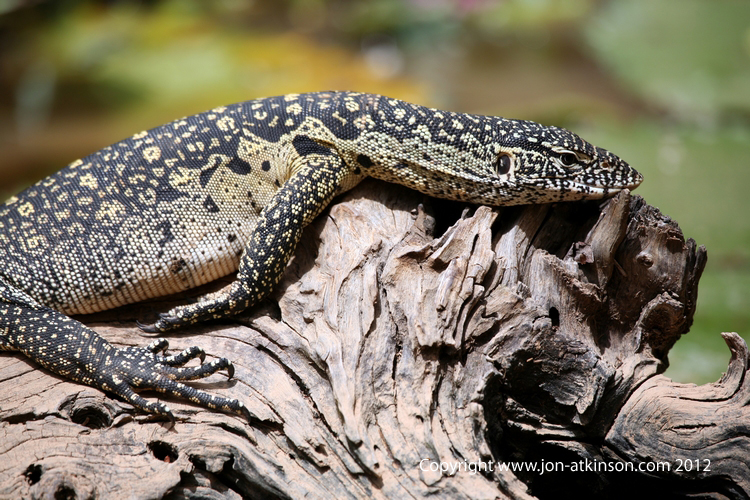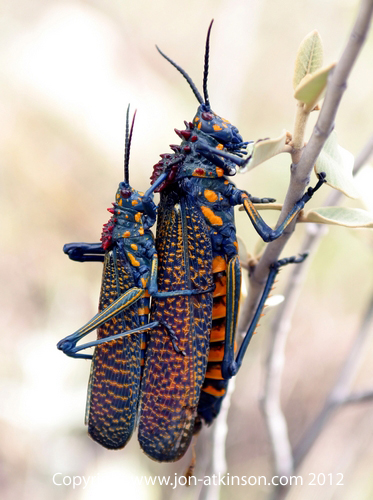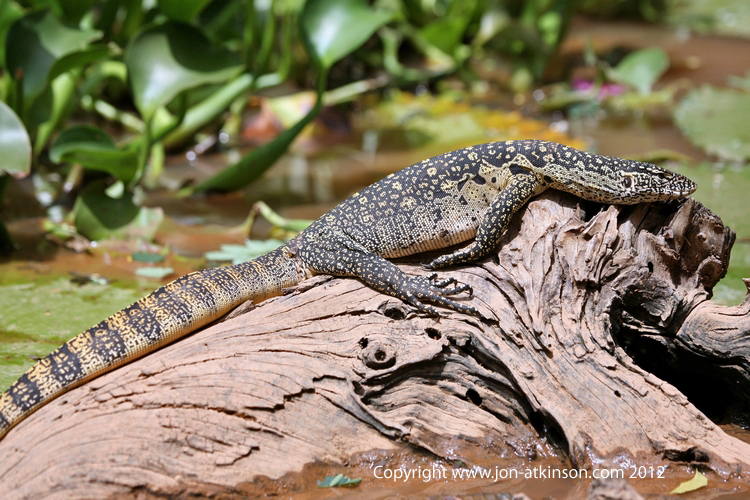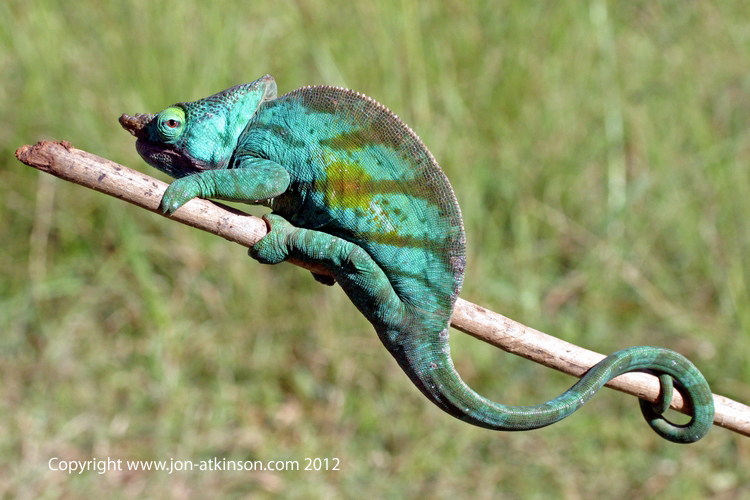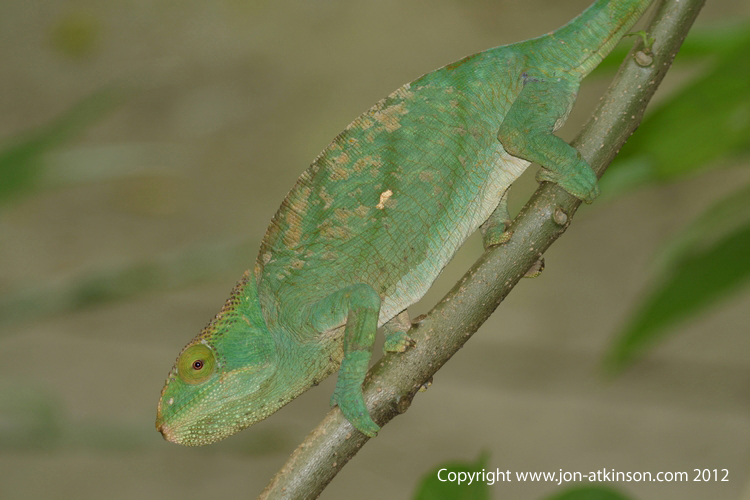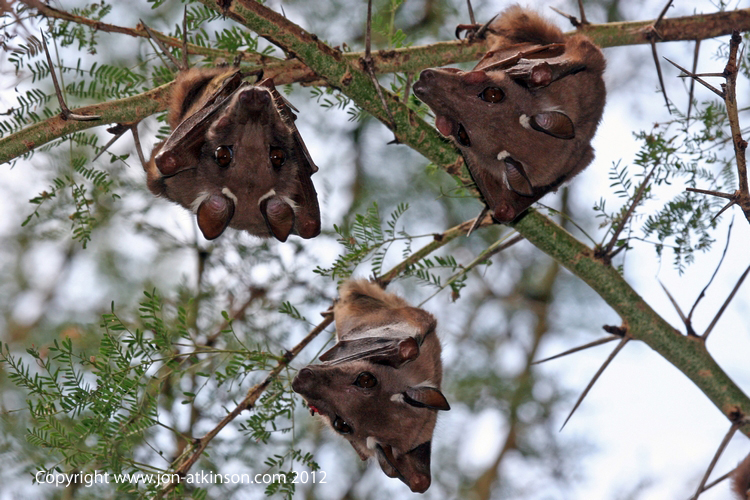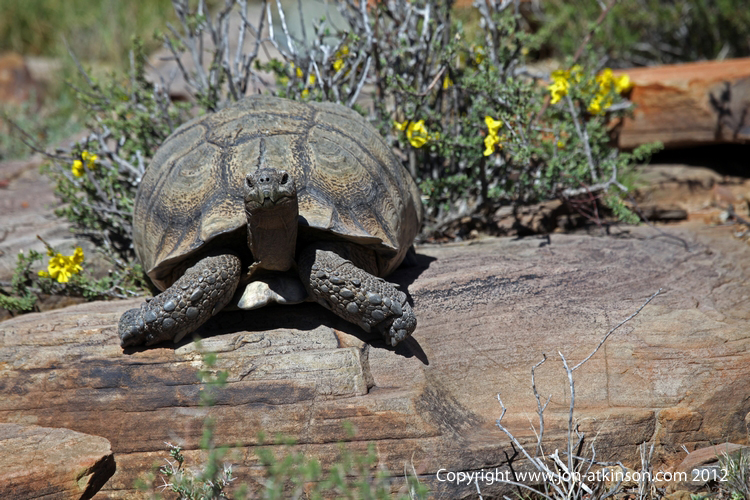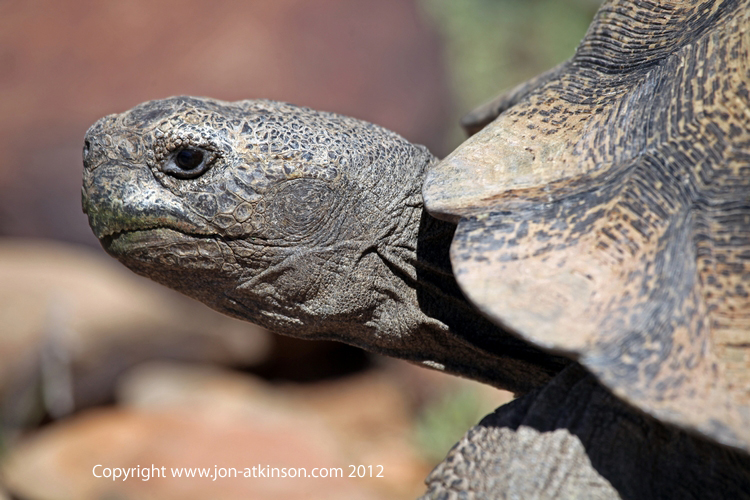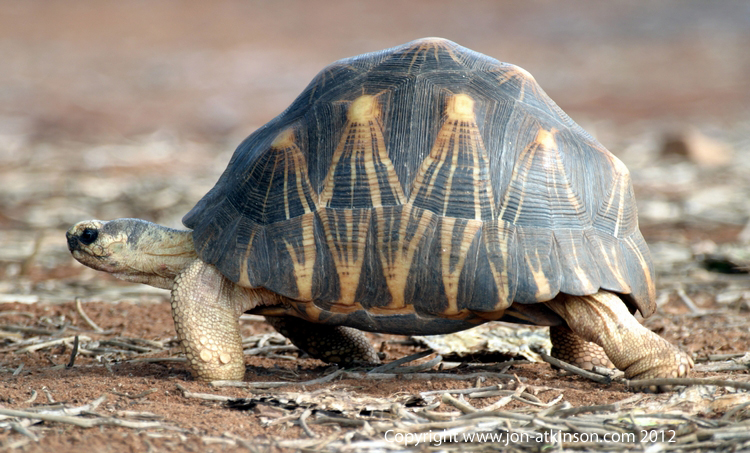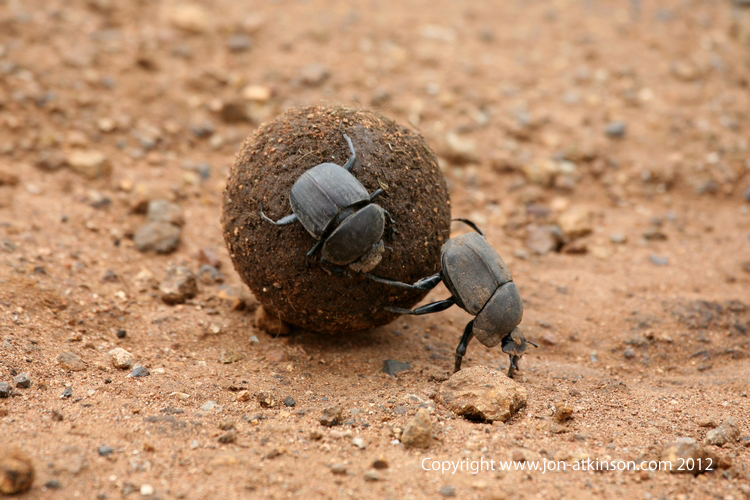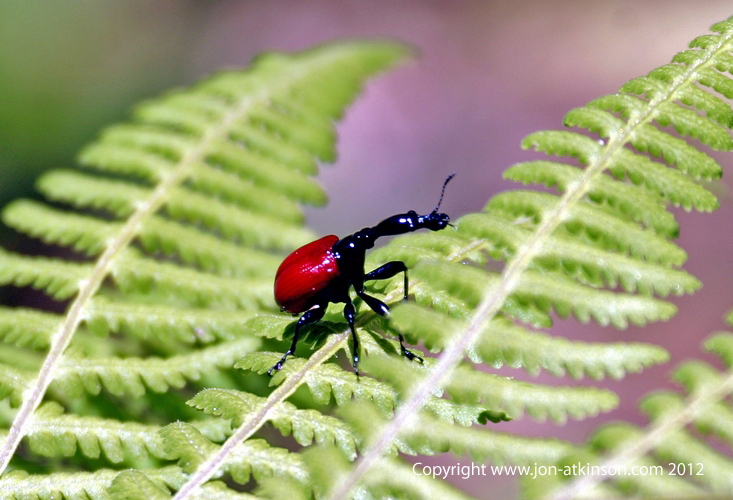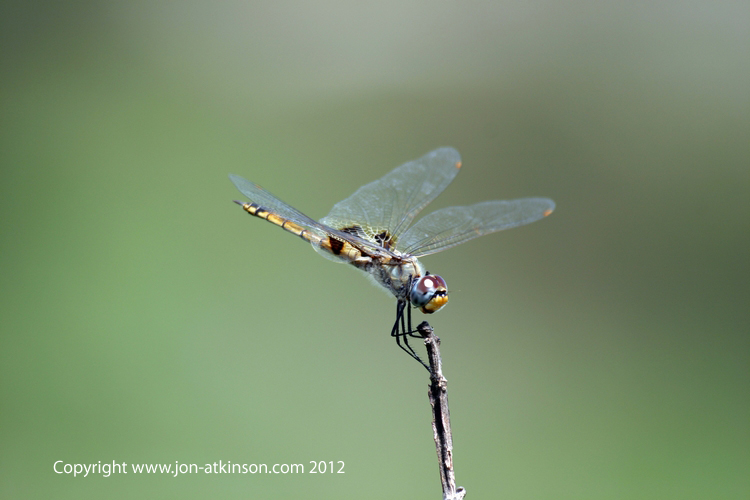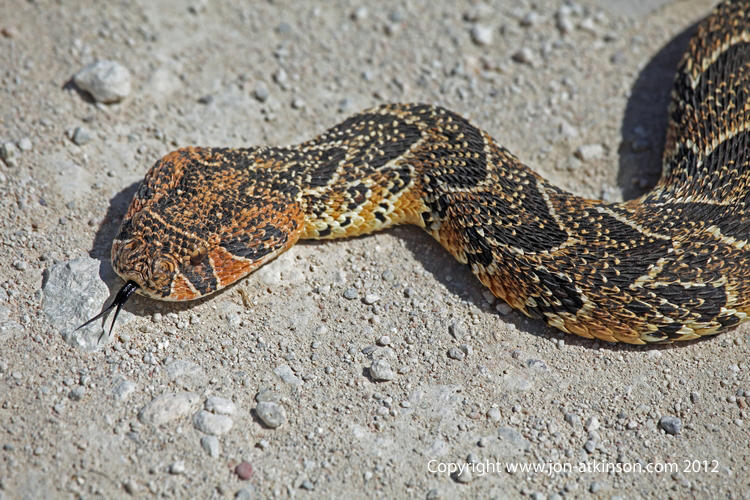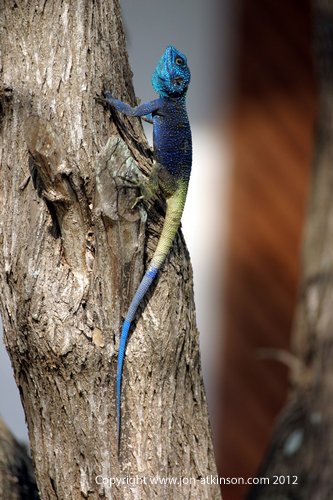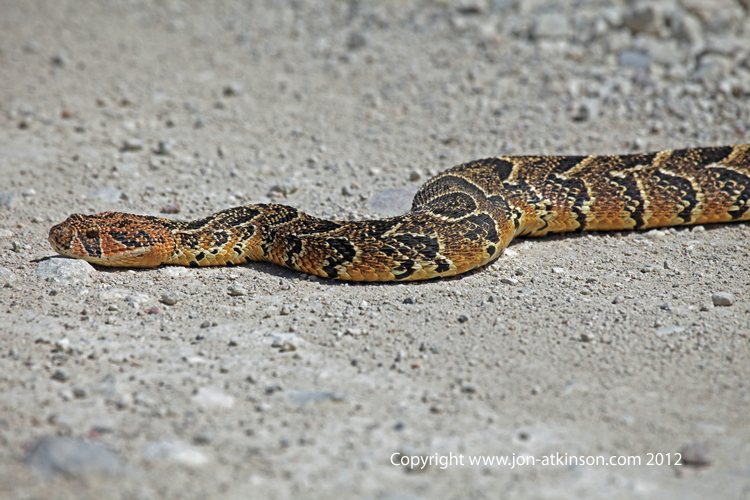AMW1 - South African Monitor Lizard (Water Leguaan): Monitors are predators, hunting on and under the ground, in trees and in the water. They differ from snakes in having movable eyelids and external ears, but they have snake-like tongues which they use in conjunction with the Jacobson's organ, a fluid-filled bi-lobed sensory organ in the roof of the mouth. The twin ends of the tongue collect odour particles from the air and then deliver them to the receptors of the Jacobson's organ, which detects differences in strength on each tongue tip and can gauge the direction of the scent, allowing the monitor to follow scent trails. |
AMW2 - Rainbow Bush Locust, Isalo N.P. Madagascar: Rainbow Bush Locust (Phymateus saxosus) is a member of the Pyrgomorphidae group of insects. The local Madagascan people call it Tumateus. It is about 10 cm, brightly colored and eats toxic plants such as Milkweed. The bright colors act as a warning to "would be" predators as the grasshopper self is highly poisonous extracting the toxins from it's diet. |
AMW3 - South African Monitor Lizard (Water Leguaan): They will eat practically anything: insects, reptiles, frogs, small mammals up to the size of domestic cats, birds and eggs, carrion and rubbish. Water monitors also catch fish and are among the most important predators of crocodile eggs. They have been observed using teamwork for this; one distracts the mother crocodile while others rush in to dig up the nest. |
AMW4 - Parson's Chameleon, Madagascar: The Parson's chameleon is endemic to eastern and northern Madagascar where it inhabits tropical forests. The Parson's chameleon is a large chameleon recognizable by the pronounced ridge that runs above its eyes and down its snout and can reaches up to 68 cm (27 in) in length (about the size of a cat) . |
AMW5 - Parson's Chameleon, Madagascar: Females of all are smaller than the males and overall greenish, yellowish or brownish (often with an orange tinge). In captivity, females lay up to 50 eggs per clutch which can take well over a year to hatch. Females only reproduce once every two years. When the babies are hatched they are on their own immediately. |
AMW6 - Chameleon, Madagascar: Madagascar is home to about half the world's 150 or so species of chameleons, including both subfamilies, typical chameleons (Chamaeleoninae) and dwarf chameleons (Brookesiinae). Chameleons are small to mid-size reptiles that are famous for their ability to dramatically change colors . Contrary to popular belief, a chameleon typically does not change colors to match its surroundings. Instead, color is usually used to convey emotions, defend territories, and communicate with mates. |
AMW7 -Agama Lizard, Serengetti National Park: Agama lizards are sometimes called rainbow lizards because of the colorful displays put on by the dominant males. While most agamas are green and brown, dominant males show off by rapidly turning their bodies blue and their heads bright red or yellow. |
AMW8 - Wahlberg's Epauletted Fruit Bat, Tazania: Wahlberg's epauletted fruit bat bat, or Epomophorus wahlbergi, is a megabat, thus is of the suborder Megachiroptera and the Pteropodidae family. Wahlberg's epauletted fruit bat is 4.25" to 6.25" long. It is tailless. It weighs two and a half to four ounces. Epaulette refers to patches of fur on the shoulders. |
AMW9 - Wahlberg's Epauletted Fruit Bat, Tanzania: Wahlberg's epauletted fruit bats sleep during the day in trees.Whilst they normally sleep individually they will form groups at trees with ripe fruit to eat. They'll spend many days at the same tree, often until it's completely rid of fruit. It is believed that Wahlberg's epauletted fruit bats may keep track of when a tree's fruit will become ripe. It is mostly nocturnal but has been seen on occasion flying during the daytime. |
AMW10 - Leopard Tortoise, South Africa: The Leopard Tortoise Stigmochelys (Geochelone) pardalis is a large grazing species that favors semi-arid (not dry), thorny to grassland habitats. They have a very attractive shell pattern. The shell pattern acts like camouflage in its natural home range. It is found throughout savannahs of Africa from Sudan to the southern Cape. Being a tropical tortoise, Leopard tortoises do not hibernate. |
AMW11 - Leopard Tortoise, South Africa: The leopard tortoise is the fourth largest species of tortoise in the world, with typical adults reaching 18-inch (460 mm) and weighing 40-pound (18 kg). Large examples may be 70-centimetre (28 in) long and weigh up to 120-pound (54 kg). Leopard tortoises are herbivorous. They are more defensive than offensive, retracting feet and head into their shell for protection. This often results in a hissing sound, probably due to the squeezing of air from the lungs as the limbs and head are retracted. |
AMW12 - Radiated Tortoise, Madagascar: Growing to a carapace length of up to 16 inches (41 cm) and weighing up to 35 pounds (16kg), the radiated tortoise is considered to be one of the world's most beautiful tortoises. Radiated tortoises occur naturally only in the extreme southern and southwestern part of the island of Madagascar. The radiated tortoise is a grazing herbivore. They feed during the day primarily on grasses, fruit and succulent plants, which form 80 to 90 percent of their diet. |
AMW13 - Dung Beetles, South Africa: Dung beetles are beetles that feed partly or exclusively on feces. All of these species belong to the superfamily Scarabaeoidea.Many dung beetles, known as rollers, are noted for rolling dung into round balls, which are used as a food source or brooding chambers. In the latter case, two beetles, one male and one female, will be seen around the dung ball during the rolling process. Usually it is the male that rolls the ball, with the female hitch-hiking or simply following behind. When a spot with soft soil is found, they stop and bury the dung ball. They will then mate underground. After the mating, they prepare the brooding ball. When the ball is finished, the female lays eggs inside it. |
AMW14 - Giraffe Beetle, Madagascar: The curious-looking giraffe weevil gets its name from its enormously long neck, which is 2-3 times longer in the males. They can use this extended neck to fight for the right to mate with a female. She, on the other hand, uses her smaller neck to roll a leaf tube nest into which a single egg is layed. One of the longest weevil species, male giraffe-necked weevils, as they're also known, grow to around 2.5cm in length. |
AMW15 - Dragonfly - Orthetrum species, Madagascar: Orthetrum is a genus of dragonflies in the Libellulidae family. It is a very large genus, spread across the Old World. |
AMW16 - Puff Adder, South Africa: The Puff Adder (Bitis arietans) is a venomous viper species found in savannah and grasslands from Morocco and western Arabia throughout Africa except for the Sahara and rain forest regions. It is responsible for causing the most fatalities in Africa owing to various factors, such as its wide distribution and frequent occurrence in highly populated regions. |
AMW17 - Blue Headed Tree Agama, Uganda: Most agamas live in small groups with the dominant male ruling over several females and sub-males. While sunning themselves each morning, the dominant male will claim the most elevated spot, with subordinates in lower areas. Agamas hunt by vision and prefer to wait for an insect to come by. Their sticky tongues help them hold onto prey. |
AMW18 - Puff Adder, South Africa: The average size of the Puff Adder is about 1 m in length and very stout. Large specimens of 190 cm (75 in), weighing over 6.0 kg (13.2 lbs) and with a girth of 40 cm (16 in) have been reported.It is found in all habitats except true deserts, rain forests, and (tropical) alpine habitats. Most often associated with rocky grasslands. Mostly nocturnal, they rarely forage actively, preferring instead to ambush prey as it happens by. Their prey includes mammals, birds, amphibians, and lizards. |

